This post may contain affiliate links, which means I’ll receive a commission if you purchase through my links, at no extra cost to you. Please read full disclosure for more information.
Yoga is great for both anxiety relief and weight loss, making it one of the best exercises for anxiety sufferers that are trying to lose weight.
Yoga can help you relieve tension, lower blood pressure and heart rate, while allowing you to lose weight naturally, safely and consistently.
Getting your anxiety under control is important for your overall health and well-being but also to lose weight effectively.
That's because anxiety can sabotage your weight loss goals, even if you eat healthily and exercise regularly.
Common anxiety symptoms - such as sleep problems, digestive issues, high cortisol levels (stress hormone), and low energy levels – are known to slow down metabolism, that negatively impacts weight loss.
Also, anxiety can lead to lack of motivation, low self-esteem and social social anxiety, likely to cause even more weight loss challenges.
Yoga is a proven and well-known method for managing anxiety. As well as calming you down physically, yoga trains the mind to stay focused on breathing (present moment), a great technique for calming your anxious mind.
Yoga has an affective role in reducing stress, anxiety and depression that can be considered as complimentary medicine.
- Study published in 2018
But also consistent yoga practice can help you lose weight.
- Directly: The more intense your yoga practice is - going faster or staying longer in yoga poses - the more calories you are likely to burn.
- Indirectly: Yoga helps to relieves stress and anxiety, improve sleep, regulate blood sugar, and boosts digestion all of which can help you lose weight as well.
Yoga may offer diverse psychological, physical, and social effects that may make it a useful tool for healthy, sustained weight loss..
- Study published in 2016
On top of that, once you start losing weight, you're likely to see improvements in your mood and self-esteem, that can relieve anxiety further.
Losing this weight is associated with a better quality of life, improved mood, better self-esteem, and a more positive attitude to life.
- Lisa Renn, spokesperson for Dietitians Association of Australia
Yoga has also helped me personally to get my anxiety under control and reach my natural weight.
After struggling with chronic anxiety for nearly 20 years, I began making changes to my diet and lifestyle and this is when I first started practicing yoga. With time and persistence, I eventually overcame my anxiety disorder, and achieved my natural weight - where yoga played a big part.
In my experience, yoga is
In this article you’ll learn how anxiety and weight are connected, top tips for weight loss and anxiety relief, and 30-minute yoga for beginners to get you started.
Table of Contents
How is Your Weight and Anxiety Connected?
Anxiety affects people in different ways. It can either cause you to continually lose weight or it can make weight loss more challenging. Both are an issue, however, weight gain is more common.
That’s why in this article, I’ll concentrate on anxiety as a weight-loss obstacle - illustrating how anxiety can interfere with your weight loss goals, and what you can do to get your weight loss back on track, while also reducing anxiety.
The following 5 ways explain how weight loss and anxiety are connected, and how anxiety can impact your weight loss plans.
Anxiety and Poor Sleep Quality
Getting high-quality sleep is essential for weight loss.
In contrast, a lack of sleep can reduce fat loss by as much as 55 percent! [1]
However, if you are struggling with anxiety, it is likely that you are also not getting enough quality sleep. That’s because stress and anxiety can cause sleeping problems or make existing problems worse, and having an anxiety disorder exacerbates the problem. [2]
Also, sleep deprivation can completely disrupt the body’s hunger system. Studies show that people who get less sleep produce more ‘ghrelin’, a hormone that triggers hunger, than people who sleep for eight hours at night.
Anxiety can increase your appetite for food.
Anxiety and Increased Cortisol
Stress and anxiety trigger a “fight-or-flight” response in your body resulting in increased levels of cortisol, also known as the stress hormone.
Stress is the worst enemy of weight loss because cortisol can actually stimulate fat production and increase your appetite.
Also, research indicates that overabundance of cortisol is connected to increased fat around the abdomen (also known as “visceral fat”), which can be resistant to traditional weight-loss efforts like diet and exercise.
Anxiety can stimulate fat production.
Anxiety and Unhealthy Eating Habits
Anxiety can trigger overeating, and there are a few possible reasons for this.
First, and as already mentioned, anxiety raises cortisol levels resulting in increased appetite.
Second, some people use food as a coping mechanism, eating comfort food when anxious in an effort to feel better.
Furthermore, anxiety can cause you to be distracted, resulting in unconscious overeating.
Other than excess eating, in stressful or anxious situations your body needs a quick burst of energy so you are also likely to crave sweet, high-fat, and salty foods, which are unhealthy.
Anxiety is likely to trigger excess eating.
Anxiety and Physical Inactivity
Adopting a regular exercise regime can absolutely help you lose weight, as well as provide ample of other health benefits. But when you are anxious and overwhelmed, putting on your gym kit and being active is usually the last thing you feel like doing.
Studies support this by showing a strong correlation between anxiety and physical inactivity.
Also, anxiety can be very draining, making you tired to exercise.
Furthermore, those suffering from social anxiety, find staying at home and watching TV, a lot “safer” than being in busy places like gyms!
However, physical inactivity means fewer calories burnt and a slow down in metabolism.
Anxiety and physical inactivity are positively correlated.
Excess Weight Can Cause Anxiety
Being overweight can in some cases be the cause of anxiety or it can make anxiety worse.
There are a few reasons for this.
People who are overweight are likely to be less active and inactivity can trigger anxiety.
This is because our bodies are designed to move. So, if we don’t have enough physical activity as part of our daily life, we are unable to release the tension created from anxiety.
Over time this can build into an anxiety avalanche! In other words, those that do not regularly exercise are more likely to develop anxiety disorders.
Excess weight can also trigger poor breathing habits, which are known to trigger anxiety symptoms and panic attacks.
Eating unhealthy foods that lead to excess weight can also contribute to anxiety and poor sleeping habits.
Further, some people feel more anxious when they can’t lose weight or when they gain weight because they lose confidence in themselves.
Troubles with weight can cause anxiety or make anxiety symptoms worse.
How to Reduce Anxiety and Lose Weight?
1. Adopt an Anti-Anxiety Diet
Adopting a healthy diet can help you reach your natural weight and manage anxiety.
But even though eating healthily is overall good for your anxiety, not all healthy foods are anxiety friendly, and so adopting an anti-anxiety diet is the best weight loss diet for anxiety sufferers.
An anti-anxiety diet is essentially a healthy diet but with a few more restrictions.
The anti-anxiety diet that helped me to reduce and manage anxiety includes:
Foods that are avoided on this diet are:
2. Increase Your Intake of Vegetables
Vegetables contain few calories but a lot of fiber. Also, their high-water content gives them low energy density, making them very filling!
Studies show that people who eat lots of vegetables tend to weigh less. [13]
Next time you’re hungry, make steamed veg and brown rice or a vegetable soup.
3. Limit Your Intake of Fruit
Fruits are high in simple sugars and consuming too much fruit can cause weight gain and trigger anxiety.
As such fruit should be limited. You don’t need to worry about missing out on any beneficial nutrients because if you eat lots of vegetables you will be covered!
Your vegetables to fruit ration should be 9:1, and you should go for the less-sweet fruits such as apples, pears, papaya, mango, and green bananas.
4. Cut Out Sugary Drinks and Fruit Juices
Sugar is unhealthy and a big anxiety trigger, but in liquid form, it’s even worse.
Research shows that liquid sugar, such as sodas and energy drinks, might be the single most fattening aspect of the modern diet. [14]
One study showed that sugar-sweetened beverages are linked to a 60% increased risk of obesity for each daily serving. [15]
Fruit juices also contain a lot of sugar, almost as much as sodas and should be avoided. [16]
5. Reduce or Eliminate Alcohol
Alcohol is high in simple sugars that contribute to weight gain and anxiety.
But also, after consuming alcohol you are likely to eat more calories.
So, drinking alcohol is definitely not helpful when it comes trying to lose weight!
In terms of calories,
- 12-ounce can of beer contains almost 155 calories
- A 5-ounce glass of red wine contains 125 calories.
To put this into perspective, a recommended afternoon snack should provide you with 50 to 200 calories.
So, if you have a few drinks on a Friday night, you can end up consuming a few hundred extra calories – sourced from simple sugars – that you will then need to burn off!
6. Chew More Slowly
It takes a while for your brain to register that you have eaten enough food, and research shows that if you chew more slowly you actually end up eating fewer calories. [16, 17]
7. Use Smaller Plates
Using smaller plates and bowls will help to reduce your calorie intake. [18]
8. Drink More Water
Increasing your intake of water will help you with weight loss.
Drinking water can boost your metabolism by as much as 30% over a period of 1–1.5 hours, helping you burn off extra calories. [25]
In particular, if you drink half a liter (17 ounces) of water about half an hour before meals can help you to eat fewer calories and lose over 40% more weight. [26]
9. Avoid Eating Before Bedtime
Eating before bedtime can cause weight gain because your metabolism slows down when you fall asleep. This causes any undigested calories to be stored as fat. Ideally, it is best not to eat 3 hours before bedtime. [27, 28, 29]
10. Get Quality Sleep
Quality sleep is essential for your physical and mental health, but it’s also necessary for weight loss.
Studies show that poor sleep is a strong risk factor for obesity, and it is associated with a 55% increase in adults and a whopping 89% in children! [30]
Aim to get 8 hours of sleep every night.
11. Start Exercising Regularly
Find a physical activity that you like and can stick to, and commit to it at least three times a week.
Regular movement will help you lose weight naturally but also reduce your anxiety symptoms, boost mood, and improve sleep quality – all of which will help you to lose weight.
If you can only do the walking, to begin with, that’s still great!
Research shows that a 30-minute walk can be just as effective for relieving anxiety as longer, more intense exercise. Of course, the more you walk and the quicker your pace, the more calories you will burn.
If you successfully implement walking into your weekly routine, it will be easier to move to the gym and start doing the kinds of workouts that can help you to burn lots more calories!
The key is to start small, then increase your physical activity, which will result in less anxiety and better weight loss results.
Short walks can lead to longer walks, which can lead to alternating walking/running, and even on to 5km.
12. Keep an Anxiety Journal
If your anxiety is keeping you awake at night, I highly recommend that you get a journal and keep it next to your bed.
That way, every time, your anxiety is disturbing your sleep, you can write down your anxious thoughts or feelings.
Writing your worries and emotions down can help you unload, see patterns in your anxiety and the problem at hand, and even help you to figure out a solution – all of which can bring anxiety relief.
Over time this can improve your sleep quality helping you to lose weight faster!
13. Try Yoga for Weight Loss
Most people don’t think of yoga for weight loss.
But consistent yoga practice can help you lose weight naturally as well as help you manage your anxiety.
Yoga works on weight loss both directly and indirectly.
The more intense your yoga practice the more calories you burn.
But also, yoga relieves stress, improves sleep, reduces food cravings, and boosts digestion all of which can help you lose weight.
The following 10 yoga poses can be practiced in the comfort of your own home. It is an ideal yoga for beginners’ sequence!
Yoga for Anxiety and Weight Loss - 10 Easy Yoga Poses
The following 10 yoga poses can be practiced in the comfort of your own home. It is an ideal yoga for beginners’ sequence!
- Hold each pose for 20 seconds. (Some poses need to be done on both sides).
- Once you have completed all ten postures, repeat another 4 times.
This sequence is about 25 minutes to 30 minutes long depending on the time taken between yoga poses or asanas. If it takes you longer that is perfectly ok. Yoga is a personal practice and not a race. Take your time and enjoy!
1. Three-Legged Dog Pose
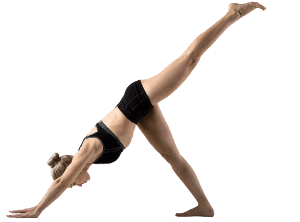
Instructions
- From downward-facing dog extend your right foot up to the sky while the opposite foot is rooted on the floor.
- Your hips should be squared and your toes active.
- The forehead is facing the earth and the gaze is toward the back.
- Hold for 20 seconds.
- Repeat on the other side.
- Watch video instructions
2. High Lunge Pose
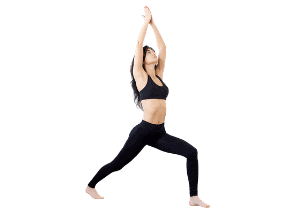
Instructions
- Root your right leg on the floor with your knee directly above.
- Your left leg should be straight with the weight distributed backward.
- The pelvis is tucked under with the ribcage lifted and the chin slightly tucked.
- The spine is long and extended, and the heart is open.
- Your arms should be straight and the hands can be together or separated and facing each other with the fingers spread wide.
- Look forward.
- Hold for 20 seconds.
- Repeat on the other side.
- Watch video instructions
3. Warrior II Pose
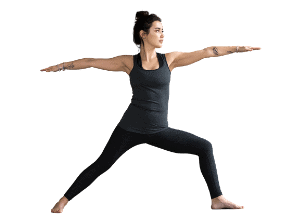
Instructions
- From standing position, separate your legs into a wide stance.
- Bend your right knee in a 90-degree angle directly above the ankle.
- The back leg is straight and extended
- Your inner thighs should be rotated away from each other
- The pelvis is tucked under and ribcage is lifted.
- Extend your arms out to the sides and align your shoulders in a straight line.
- Reach the fingers out and squeeze your shoulder blades together.
- The gaze is toward the front fingers.
- Hold for 20 seconds.
- Repeat on the other side.
- Watch video instructions
4. Half Moon Pose

Instructions
- From standing position, keep your right leg straight and extend your left leg back parallel to the floor (as much as you can).
- Place your right hand on the floor and extend your left hand up toward the sky.
- Squeeze your shoulder blades together and reach your fingers outward in opposing directions.
- The weight of the body should be mainly supported by the standing leg, and the hand on the floor should be used simply for balance.
- Rotate upper torso toward the sky.
- Both hips should be externally rotated.
- Your gaze can be either up or down, depending on your neck.
- Hold for 20 seconds.
- Repeat on the other side.
- Watch video instructions
5. Warrior III Pose
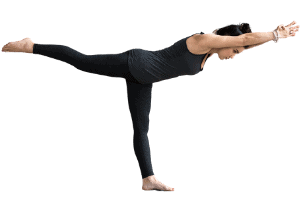
Instructions
- From standing position, keep your right leg straight and extend your left leg back parallel to the floor (as much as you can).
- Press your right leg into the ground.
- Extend both arms in the opposite directions of the extended back leg.
- Your hips should be squared and tailbone pressed firmly into the pelvis.
- Your arms, torso, and extended raised back leg should be relatively parallel to the floor.
- The gaze is forward or down.
- Hold for 20 seconds.
- Repeat on the other side.
- Watch video instructions
6. Tree Pose

Instructions
- From standing position, root your right foot into the floor.
- Lift your left foot and root the heel into the inner thigh with the toes pointing toward the floor.
- Tuck in your pelvis and chin.
- Bring your hands together at the heart.
- The gaze is forward.
- Hold for 20 seconds.
- Repeat on the other side.
- Watch video instructions
7. Chair Pose
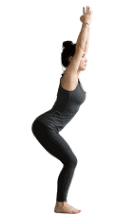
Instructions
- From standing position, keep your feet together and root them into the ground with toes actively lifted.
- Bend your knees slightly keeping your weight of the body on the heels of the feet.
- The pelvis is tucked in and the ribcage is lifted.
- Your neck should be a natural extension of the spine.
- Lift your arms up toward the sky with the elbows straight.
- Your hands can be together or separated and facing each other with the fingers spread wide.
- The gaze is forward.
- Hold for 20 seconds
- Watch video instructions
8. Standing Fold Pose

Instructions
- From standing position, fold your body over at the hip with the spine long.
- Relax your neck.
- The crown of your head should be toward the floor.
- Root your feet into the floor with toes actively lifted.
- Your spine should be straight and the ribcage lifted.
- Connect your chest with thighs as much as you can.
- Lift your sacrum up toward the sky in dog tilt.
- Rest your fingertips on the floor next to your toes.
- The gaze is down or slightly forward.
- Hold for 20 seconds.
- Watch video instructions
9. Locust Pose

Instructions
- Lie down on your belly facing the floor with your arms along the side of your body and palms facing up.
- Then lift both legs away from the floor until you are resting on the lower ribs, belly, and front pelvis.
- Your buttocks should be firm, legs and toes should be strong and active.
- Now also raise your arms parallel to the floor keeping your fingertips active.
- The gaze is forward or slightly upward.
- Lift your head and keep the back of your neck long.
- Hold for 20 seconds.
- Watch video instructions
10. Bridge Pose
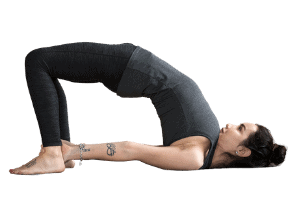
Instructions
- Lie down on your back.
- Lift up your hips with the heels of the feet rooted into the ground to the sitting bones.
- Your toes should be actively lifted and your pelvis tucked.
- The thighs are parallel to the floor.
- Now interlace your fingers under the body with the ribcage lifted and the heart open.
- The back of your neck should rest on the floor.
- The gaze is to the sky.
- Hold for 20 seconds
- Watch video instructions
Latest posts by Sandra Glavan, Life Coach for Gentle Anxiety Sufferers (see all)
- How to Live Your Best Life as a Highly Sensitive Person? - 14th October 2023
- How to Sleep Better and Longer? Top 5 Tips - 1st October 2023
- How to Let Go of Control and Relieve Anxiety? - 22nd September 2023
